alaska
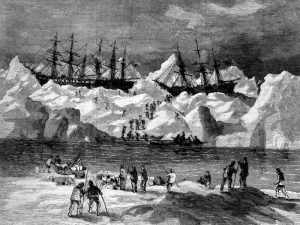 Over the centuries, many ships have been lost at sea, but it isn’t every day that 33 ships are lost together. That was the case in September of 1871, however, when the ice off of the coast of Alaska trapped 33 out of 40 commercial whaling ships who were hunting for bowhead whales in the Artic Ocean. Normally, when ice traps a ship, it eventually releases it’s grip with the shifting winds, but in this case that didn’t happen, and the results were disastrous. Within a few weeks, the ships were destroyed, and the families and crew members had to evacuate and head for one of the ships that was not trapped. As the 1,219 additional people boarded the remaining 7 ships, those ships became overloaded. They had to throw things overboard to allow for the extra weight. Things like their equipment and their precious cargo were lost. The already struggling whaling industry in the United States was basically dealt a final blow. The amazing thing was that no one died, but the loss of 33 ships over those weeks was devastating enough to the whaling industry.
Over the centuries, many ships have been lost at sea, but it isn’t every day that 33 ships are lost together. That was the case in September of 1871, however, when the ice off of the coast of Alaska trapped 33 out of 40 commercial whaling ships who were hunting for bowhead whales in the Artic Ocean. Normally, when ice traps a ship, it eventually releases it’s grip with the shifting winds, but in this case that didn’t happen, and the results were disastrous. Within a few weeks, the ships were destroyed, and the families and crew members had to evacuate and head for one of the ships that was not trapped. As the 1,219 additional people boarded the remaining 7 ships, those ships became overloaded. They had to throw things overboard to allow for the extra weight. Things like their equipment and their precious cargo were lost. The already struggling whaling industry in the United States was basically dealt a final blow. The amazing thing was that no one died, but the loss of 33 ships over those weeks was devastating enough to the whaling industry.
Not much was found of the ships for many years, although debris washed up on shore periodically. Still, no artifacts specifically tied to the shipwrecks could be found beneath beneath the water. In 2015, thanks to technological advances, archaeologists have found the wreckage of what appears to be two of the lost ships. They are located at the bottom of the Chukchi Sea off the coast of Wainwright, Alaska, but an exact location is not being given. Brad Barr, an archaeologist with the National Oceanic and Atmospheric Administration (NOAA), estimated the losses caused by what has been dubbed the Great Whaling Disaster of 1871 would have reached the equivalent of a little more than $33 million today. As Barr told LiveScience: “The event has been attributed as possibly a major contributory factor in the demise of whaling in the U.S.”
Barr began his hunt in late August 2015. He and a team of researchers from the Maritime Heritage Program of the NOAA’s Office of National Marine Sanctuaries surveyed the floor of the Chukchi Sea off the coast of the Inupiat village of Wainwright, in northwestern Alaska. They used state of the art sonar and underwater sensing technologies. They found the magnetic signatures of two shipwrecks they believe are part of the lost 1871 fleet, including the outlines of their flattened hulls. Underwater video revealed anchors, fasteners, pins, and ballast. They even discovered some of the special brick lined pots that the whalers used to heat the whale blubber to turn it into whale oil that was used to fire up oil lamps and make soap, margarine, and other products before the advent of petroleum. While the scientists can’t say definitively that the two wrecked ships were among the 33 lost in 1871, there are a lot of signs that point to it. More than half of all the ships known to have wrecked in the area went down in the 1871 event, and both wrecks, their beams and hull timbers were similar to those used in whaling ships from the late 19th century. The team was also aided in their efforts by changing sea ice levels, increasing opportunities to uncover lost shipwrecks even off Alaska’s northern coast. During the  expedition to the Chukchi Sea, the absence of ice was notable, and the archaeologists reportedly found artifacts from the wrecked ships “just sitting there” for them to find, Barr’s said. The team discovered remnants of a sandbar, which they believe protected the artifacts from sea ice. The NOAA is not really worried that the historic site will be disturbed, because historic preservation laws still apply. Also, there is no gold bullion, jewels or other precious cargo that might draw fortune hunters. Nevertheless, they are not publicizing the site’s exact location. Instead, they will provide all information to the Alaska Office of History and Archaeology, the agency in charge of protecting sites and relics in Alaska.
expedition to the Chukchi Sea, the absence of ice was notable, and the archaeologists reportedly found artifacts from the wrecked ships “just sitting there” for them to find, Barr’s said. The team discovered remnants of a sandbar, which they believe protected the artifacts from sea ice. The NOAA is not really worried that the historic site will be disturbed, because historic preservation laws still apply. Also, there is no gold bullion, jewels or other precious cargo that might draw fortune hunters. Nevertheless, they are not publicizing the site’s exact location. Instead, they will provide all information to the Alaska Office of History and Archaeology, the agency in charge of protecting sites and relics in Alaska.
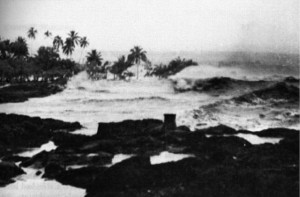 Most of us think of April 1st as April Fools Day…a day recognized all over the world as a day set aside to pull pranks, hoaxes, and practical jokes on your friends neighbors and co-workers. I can remember many pranks pulled by my sisters, my parents, and me over the years. But, not everything that happens on April 1st can be considered a funny joke…as was the case on April 1, 1946, when a 7.4 magnitude earthquake was recorded in the North Pacific Ocean off of Unimak Island. The island is a part of the Aleutian chain in Alaska. When the earthquake struck, in the middle of the night, 13,000 feet beneath the surface of the ocean, a devastating tidal wave immediately hit the nearest land…Unimak Island. The wave estimated at 100 feet high, crashed into a lighthouse located 30 feet above sea level, where a five people lived. The lighthouse was smashed and the people living inside were killed instantly. They had no warning of impending disaster and death.
Most of us think of April 1st as April Fools Day…a day recognized all over the world as a day set aside to pull pranks, hoaxes, and practical jokes on your friends neighbors and co-workers. I can remember many pranks pulled by my sisters, my parents, and me over the years. But, not everything that happens on April 1st can be considered a funny joke…as was the case on April 1, 1946, when a 7.4 magnitude earthquake was recorded in the North Pacific Ocean off of Unimak Island. The island is a part of the Aleutian chain in Alaska. When the earthquake struck, in the middle of the night, 13,000 feet beneath the surface of the ocean, a devastating tidal wave immediately hit the nearest land…Unimak Island. The wave estimated at 100 feet high, crashed into a lighthouse located 30 feet above sea level, where a five people lived. The lighthouse was smashed and the people living inside were killed instantly. They had no warning of impending disaster and death.
The Wave then headed toward Hawaii, at 500 miles an hour. Hawaii was 2,400 miles south of the epicenter. 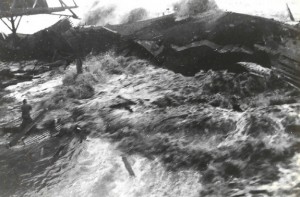 Captain Wickland of the United States Navy spotted the coming wave at about 7am…four and a half hours after the quake. Wickland’s position on the bridge was 46 feet above sea level, and he said he was eye level with a “monster wave” that was two miles long. I can only imagine how he must have felt looking at that wave. The word helpless is the first word to come to my mind. As the wave came into Hilo Bay, the water first receded, leaving ships on the sea floor beside fish flopping in the sand. Then, the tsunami struck full force. The wave was 32 feet high, and it completely destroyed about a third of the city. The Wailuku River bridge was picked up and relocated 300 feet from it’s original position. In Hilo, 96 people lost their lives. Other parts of Hawaii were hit by waves up to 60 feet. In Laupahoehoe, a schoolhouse was crush, killing the teacher and 25 students. The tsunami was seen as far away as Chili, where unusually high waves crashed ashore 18 hours after the earthquake hit. There were no casualties were reported there.
Captain Wickland of the United States Navy spotted the coming wave at about 7am…four and a half hours after the quake. Wickland’s position on the bridge was 46 feet above sea level, and he said he was eye level with a “monster wave” that was two miles long. I can only imagine how he must have felt looking at that wave. The word helpless is the first word to come to my mind. As the wave came into Hilo Bay, the water first receded, leaving ships on the sea floor beside fish flopping in the sand. Then, the tsunami struck full force. The wave was 32 feet high, and it completely destroyed about a third of the city. The Wailuku River bridge was picked up and relocated 300 feet from it’s original position. In Hilo, 96 people lost their lives. Other parts of Hawaii were hit by waves up to 60 feet. In Laupahoehoe, a schoolhouse was crush, killing the teacher and 25 students. The tsunami was seen as far away as Chili, where unusually high waves crashed ashore 18 hours after the earthquake hit. There were no casualties were reported there.
The tsunami brought to light a need for some kind of a warning system. The warning system, called the Seismic SeaWave Warning System was established two years later. It is now known as the Pacific Tsunami  Warning System, and it uses undersea buoys throughout the ocean, along with seismic activity detectors to predict killer waves. The system is still in use, and has warned many people in time to get to safety. Nevertheless, on its first use…November 4, 1952, the people evacuated successfully, but the wave never materialized. I suppose that could have been listed as a successful failure, but in that case, it wasn’t about whether or not the wave came, but rather, if it did, that the people were safely away. A system like this one can’t save everyone. I’m sure that some waves just get to land too quickly, but every life saved matters. The April Fools Day tsunami was on April 1st, but no one would call it a joke… and that’s for sure.
Warning System, and it uses undersea buoys throughout the ocean, along with seismic activity detectors to predict killer waves. The system is still in use, and has warned many people in time to get to safety. Nevertheless, on its first use…November 4, 1952, the people evacuated successfully, but the wave never materialized. I suppose that could have been listed as a successful failure, but in that case, it wasn’t about whether or not the wave came, but rather, if it did, that the people were safely away. A system like this one can’t save everyone. I’m sure that some waves just get to land too quickly, but every life saved matters. The April Fools Day tsunami was on April 1st, but no one would call it a joke… and that’s for sure.
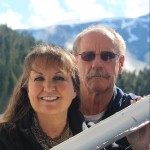 Because Bob and I took a cruise to Alaska last year, I have found myself interested in all things Alaskan. I don’t really think I would want to move to Alaska, because I am a bit of a wimp when it comes to snow and cold, but I have to say that Alaska is absolutely beautiful…and yes, I would got back for a vacation again…in a heartbeat. While I didn’t like the cool weather, Alaska is a place like no other. The United States took possession of Alaska on this day October 18, 1867, after purchasing it for $7.2 million…less than 2 cents an acre. The Alaska purchase comprised 586,412 square miles, about twice the size of Texas, and was championed by William Henry Seward, the enthusiastically expansionist secretary of state under President Andrew Johnson. Many people thought the purchase was frivolous. Public opinion of the purchase turned more favorable when gold was discovered in a tributary of Alaska’s Klondike River in 1896, sparking a gold rush. Alaska became the 49th state on January 3, 1959, and is now recognized for its vast natural resources and great beauty.
Because Bob and I took a cruise to Alaska last year, I have found myself interested in all things Alaskan. I don’t really think I would want to move to Alaska, because I am a bit of a wimp when it comes to snow and cold, but I have to say that Alaska is absolutely beautiful…and yes, I would got back for a vacation again…in a heartbeat. While I didn’t like the cool weather, Alaska is a place like no other. The United States took possession of Alaska on this day October 18, 1867, after purchasing it for $7.2 million…less than 2 cents an acre. The Alaska purchase comprised 586,412 square miles, about twice the size of Texas, and was championed by William Henry Seward, the enthusiastically expansionist secretary of state under President Andrew Johnson. Many people thought the purchase was frivolous. Public opinion of the purchase turned more favorable when gold was discovered in a tributary of Alaska’s Klondike River in 1896, sparking a gold rush. Alaska became the 49th state on January 3, 1959, and is now recognized for its vast natural resources and great beauty.
Since we were there, I found an app for my phone that tells me about earthquakes around the world, and since 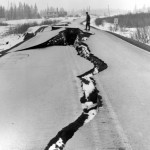 Alaska gets a lot of them, the names of some of the places we were at have shown up on my app periodically. There haven’t been any huge earthquakes, but there are still earthquakes. The reason earthquakes grabbed my interest was because of a movie we watched in Anchorage, about the about the 1964 Great Alaska Earthquake that occurred there. It was the largest earthquake in the history of the United States, registering 9.2 on the Richter Scale. The devastation from that earthquake is something that I will never forget. I wasn’t even there, and I will never forget it. When we walked past the area where so many houses were simply swallowed up…well, it was an eerie feeling. It was hard to shake it. One minute people were living their lives, and the next they are buried alive. Still, life moved on, and people persevered.
Alaska gets a lot of them, the names of some of the places we were at have shown up on my app periodically. There haven’t been any huge earthquakes, but there are still earthquakes. The reason earthquakes grabbed my interest was because of a movie we watched in Anchorage, about the about the 1964 Great Alaska Earthquake that occurred there. It was the largest earthquake in the history of the United States, registering 9.2 on the Richter Scale. The devastation from that earthquake is something that I will never forget. I wasn’t even there, and I will never forget it. When we walked past the area where so many houses were simply swallowed up…well, it was an eerie feeling. It was hard to shake it. One minute people were living their lives, and the next they are buried alive. Still, life moved on, and people persevered.
It takes a rather tough breed of people to live in Alaska. The weather gets extreme, and much of the state is, and always will be a wilderness area. Half of the year has extra long days, and half of the year has extra long nights. Yet, even with the extreme and sometimes brutal weather, the people of Alaska stay there. They work hard all summer to prepare for the long winter, and in summer’s long days, they are outside enjoying the fresh 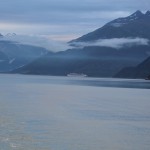 air well into the nighttime hours, because they know that the winter is coming and with it will be the short, cold, dark days. I don’t think most of us could handle Alaska, and yet those who do feel that it is a gift. And that is something I can understand.
air well into the nighttime hours, because they know that the winter is coming and with it will be the short, cold, dark days. I don’t think most of us could handle Alaska, and yet those who do feel that it is a gift. And that is something I can understand.
While I didn’t get to see the Aurora Borealis, I know that I would go back to Alaska for an Aurora Tour in a heartbeat. The mountains there are beautiful, and everything has a feeling of vastness. Alaska is a beautiful state, and one I would really recommend that people visit. While I wouldn’t live there, I would definitely go back there. You simply can’t see Alaska in a one week trip. All that does is whet your appetite. I’m really glad that we purchased Alaska, even if the people weren’t sure it was a great idea at first.

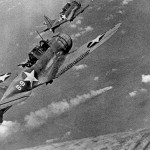 The Japanese navy in 1942 was a power that seemed impossible to beat. They had not lost a battle since their defeat the Battle of Shimonoseki Straits in 1863. It was the goal of the Japanese operation to eliminate the United States as a strategic power in the Pacific…the same reason the attack on Pearl Harbor was important to them. On June 4, 1942, Japanese Admiral Chuichi Nagumo, commander of the fleet that attacked Pearl Harbor, launched a raid on Midway Island with almost the entire Japanese navy. It was to be a decisive battle. Their plan was to make another power grab that that would widen their sphere of influence and conquest. They set their sights on Midway, an island group in the central Pacific, as well as on the Aleutians, off the coast of Alaska. The United States Navy was badly wounded, and the Japanese were determined to finish it off.
The Japanese navy in 1942 was a power that seemed impossible to beat. They had not lost a battle since their defeat the Battle of Shimonoseki Straits in 1863. It was the goal of the Japanese operation to eliminate the United States as a strategic power in the Pacific…the same reason the attack on Pearl Harbor was important to them. On June 4, 1942, Japanese Admiral Chuichi Nagumo, commander of the fleet that attacked Pearl Harbor, launched a raid on Midway Island with almost the entire Japanese navy. It was to be a decisive battle. Their plan was to make another power grab that that would widen their sphere of influence and conquest. They set their sights on Midway, an island group in the central Pacific, as well as on the Aleutians, off the coast of Alaska. The United States Navy was badly wounded, and the Japanese were determined to finish it off.
The Americans were weakened, that was true, but the Japanese sorely misjudged the determination of the American warrior. The Yorktown had been damaged, and there would only be three days to get her repaired and ready for battle. She would be used, along with the Enterprise and the Hornet for this battle. They were all that was left of the aircraft carriers after the attack on Pearl Harbor. The question on the minds of everyone…would it be enough? Only time would tell. And there was no more time. The battle had begun.
The attack came in the morning, on June 4th. Admiral Nagumo wanted to lure the United States aircraft carriers into a trap. He launched his first strike with 108 aircraft…bringing significant damage to the US installations at Midway. The Americans struck back over and over, but accomplished little, losing 65 of their aircraft in those first attempts. The Japanese admiral was sure that his plan had worked. He could almost taste victory, but he had underestimated the tenacity and determination of Admiral Chester Nimitz and Admiral Raymond Spruance, the commanders of the American forces. Admiral Nagumo ordered a second wave of bombers to finish off what he thought was only a remnant of American resistance. This was when he found out just how wrong he had been, and how badly he had misjudged the Americans. The American Admirals had anticipated the attack on Midway, and they managed to conceal their position because of good reconnaissance, which gave them sufficient opportunity to rearm.
The Americans sent in 55 US dive-bombers to take full advantage of Admiral Nagumo’s confusion. He honestly thought this battle would be a simple, but decisive win for the Japanese, but his world came crashing down when the Americans sunk three of the four Japanese carriers, all of them cluttered with aircraft and fuel, ready to launch another attack. The realization came to Admiral Nagumo after it was too late. The Americans had a much larger naval force that he had expected. The Japanese carrier, the Hiryu was crippled, but not before it finished off the American carrier Yorktown.
The attack on Midway was a complete disaster for the Japanese. In all, they lost 322 aircraft and 3,500 men. 
 They were forced to withdraw from the area before even attempting a landing on the island that had been their goal for the attack. Midway was safe, and the Japanese went away with a major lesson learned. The Battle of Midway took place roughly at the middle of World War II, and things went downhill from that point on for the Japanese. They would not win this war, but rather would surrender on September 2, 1945. They took away a new understanding of the American war machine after World War II. The United States was a formidable foe, and one that refused to give up to evil nations.
They were forced to withdraw from the area before even attempting a landing on the island that had been their goal for the attack. Midway was safe, and the Japanese went away with a major lesson learned. The Battle of Midway took place roughly at the middle of World War II, and things went downhill from that point on for the Japanese. They would not win this war, but rather would surrender on September 2, 1945. They took away a new understanding of the American war machine after World War II. The United States was a formidable foe, and one that refused to give up to evil nations.
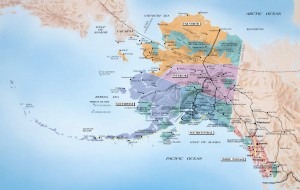 Until recently, I had never given much thought to historic events concerning Alaska. It wasn’t that I wasn’t interested, but rather that other places occupied my mind. Nevertheless, with the recent trip Bob and I took, Alaska has found a place in my mind and heart. Does that mean I have the Alaska Bug…well maybe, because if you offered me a free trip, I would be there with bells on. That said, I noticed the fact that today is a hugely significant day in Alaska’s history. Alaska became a state on December 7, 1959, the 50th state, Hawaii joined the union on August 21, 1959. It is very strange to think that it took almost 172 years to acquire all 50 states, and the final two joined within my lifetime. In our minds, we rather expect that all the states would have been within the first hundred years of each other, but such was not the case at all. Nevertheless, all but two states were within the first 125 years, with only the last two joining 47 years later.
Until recently, I had never given much thought to historic events concerning Alaska. It wasn’t that I wasn’t interested, but rather that other places occupied my mind. Nevertheless, with the recent trip Bob and I took, Alaska has found a place in my mind and heart. Does that mean I have the Alaska Bug…well maybe, because if you offered me a free trip, I would be there with bells on. That said, I noticed the fact that today is a hugely significant day in Alaska’s history. Alaska became a state on December 7, 1959, the 50th state, Hawaii joined the union on August 21, 1959. It is very strange to think that it took almost 172 years to acquire all 50 states, and the final two joined within my lifetime. In our minds, we rather expect that all the states would have been within the first hundred years of each other, but such was not the case at all. Nevertheless, all but two states were within the first 125 years, with only the last two joining 47 years later.
Alaska was first discovered in 1741 when a Russian expedition led by a Danish navigator named Vitus Bering sighted the Alaskan mainland. Before long Russian hunters were making trips into Alaska, and their presence wreaked havoc on the Aleutian people, who had been relatively disease free prior to their exposure to foreign diseases. The first permanent Russian colony in Alaska was established on Kodiak Island in 1784 by Grigory Sheliknov. Settlements spread across the west coast of North America during the 19th century, with the southernmost fort located near Bodega Bay in California. By the 1820’s, the Russians were spending less and less time in the new world, and the British and Americans were allowed to trade in Alaska…after a few diplomatic conflicts. By the 1860s, Russia was nearly bankrupt, and so they decided to offer Alaska for sale to the United States, because they had expressed an interest earlier. The purchase took place on March 30, 1867  when Secretary of State William H Seward…I wondered where some of the names came from…signed the agreement and the United States purchased Alaska for 7.2 million…which was about two cents an acre…quite a deal really. Nevertheless, the purchase was ridiculed by Congress and the place was called “Seward’s Folly”, “Seward’s Icebox”, and President Andrew Johnson’s “polar bear garden” for some time. Still, the Senate ratified the purchase of this vast land that measured one fifth of the size of the continental United States.
when Secretary of State William H Seward…I wondered where some of the names came from…signed the agreement and the United States purchased Alaska for 7.2 million…which was about two cents an acre…quite a deal really. Nevertheless, the purchase was ridiculed by Congress and the place was called “Seward’s Folly”, “Seward’s Icebox”, and President Andrew Johnson’s “polar bear garden” for some time. Still, the Senate ratified the purchase of this vast land that measured one fifth of the size of the continental United States.
Settlement of the new territory was very slow. It seemed that people didn’t feel comfortable about this cold, desolate wilderness, where the sun didn’t act like it did in the rest of their world. Nevertheless, all their apprehension was quickly forgotten with the discovery of gold in 1898. People moved to Alaska in droves to try to make their fortune. In my travels to Alaska, I had the opportunity to watch a movie about the Klondike Gold Rush. While people did find gold, it came at a heavy price, and many people paid the ultimate price. This land was an unforgiving place. Those who were not prepared for it’s harshness, soon found out what it took to live there, and not everyone could do so. It didn’t make them less manly, it just wasn’t for everyone…gold or no gold.
Still, those people who came to Alaska and felt an instant connection, knew in their hearts that this harsh, vast wilderness had somehow gotten into their blood. That is how Alaskans feel about their state to this day. Not everyone is cut out for it, and they do have a tendency to laugh and joke a bit about the light weights who go home, but they also understand that the ones who stay are a bit of a rare breed. In years gone by, we would have called them Mountain Men, and I suppose that fits the early Alaskan people, but by the same token, they would not have made it either, had it not been for the wisdom of the Aleutian people concerning their health. There weren’t all kinds of things like antibiotics, and immune system boosters then. And fruits and such were not plentiful either. But the Aleutian people knew of ways to get vitamin C and other things to prevent disease.  Even so, at that time, people did not stay permanently in Alaska. They summered there. Many people still do. They just don’t like the winters there. And yet, if you look, there are areas of Alaska…along the coast, like Anchorage that is actually warmer than places like Chicago. Of course, the interior just doesn’t fall into the warm category, with temperatures reported as low as -65° is some places. I think I might want to get out of there for the winter too. Nevertheless, Alaska is an amazing state, and one that I would love to visit again. Not only is it big in size, but everything there seems huge. The mountains are amazing, and the glaciers awe inspiring. If you ever get the chance to visit our 49th state, it is a trip you will never forget…believe me.
Even so, at that time, people did not stay permanently in Alaska. They summered there. Many people still do. They just don’t like the winters there. And yet, if you look, there are areas of Alaska…along the coast, like Anchorage that is actually warmer than places like Chicago. Of course, the interior just doesn’t fall into the warm category, with temperatures reported as low as -65° is some places. I think I might want to get out of there for the winter too. Nevertheless, Alaska is an amazing state, and one that I would love to visit again. Not only is it big in size, but everything there seems huge. The mountains are amazing, and the glaciers awe inspiring. If you ever get the chance to visit our 49th state, it is a trip you will never forget…believe me.

 As another year comes to a close, my mind drifts back to the events that have taken place over the last twelve months. it seems like every year I’m alive goes by faster than the one before it. Christmas last year was just here, and before my very eyes, it was Christmas again. As a kid, it seemed like each year took ten years to pass, and now it seems like mere days.
As another year comes to a close, my mind drifts back to the events that have taken place over the last twelve months. it seems like every year I’m alive goes by faster than the one before it. Christmas last year was just here, and before my very eyes, it was Christmas again. As a kid, it seemed like each year took ten years to pass, and now it seems like mere days.
Last year ended with my sister-in-law, Brenda Schulenberg beginning a journey toward health, and this year, she has shown us just what determination and consistency can accomplish, by losing over 275 pounds. She looks amazing, and her new active lifestyle is giving her a new found happiness and a definite glow. Her success has motivated several others in the family to get back on the bandwagon toward health, myself included.
The grandkids have grown up before your very eyes, and we now have two high school graduates. Our grandson Christopher Petersen, left us this year to venture off to Sheridan to begin the journey to build his dream of becoming a great chef, and or restaurant or hotel owner. It’s been hard having him be away from home and yet we are thankful that he isn’t so far away as to make trips home impossible. Our granddaughter, 
 Shai Royce has entered the workforce full time, at the Hilton Inn. She is unsure of her future goals, so working is a good option. Our grandson, Caalab Royce is a senior in high school and will graduate in May. He is exploring the options for college to learn to make guitars…a longtime dream of his. And our grandson, Joshua Petersen is a sophomore in high school this year. Josh loves track, but with a knee injury, the season, or at least the indoor season, is up in the air until the doctor gives him the go ahead.
Shai Royce has entered the workforce full time, at the Hilton Inn. She is unsure of her future goals, so working is a good option. Our grandson, Caalab Royce is a senior in high school and will graduate in May. He is exploring the options for college to learn to make guitars…a longtime dream of his. And our grandson, Joshua Petersen is a sophomore in high school this year. Josh loves track, but with a knee injury, the season, or at least the indoor season, is up in the air until the doctor gives him the go ahead.
The past year has proven to be a pretty good one for The Moms. My mom, Collene Spencer took a couple of falls, but other than a couple of staples in her head, she is fine, and we are planning on physical therapy to strengthen her legs in the new year. My mother-in-law, Joann Schulenberg continues to thrive at Shepherd of the Valley Care Center, where she has lived for almost two years now. Both moms are happy where they are, and their living situations are a perfect fit for them. My mom’s mind is clear, so being at home is a workable situation, and since my sister, Cheryl Masterson lives with Mom, there is someone with her in the evenings anyway. Alzheimer’s Disease has made it impossible for my mother-in-law to live on her own, but since she doesn’t realize that Dad is gone, and that she is in a nursing home, she experiences no sorrow over her situation.
The past year brought our family a new addition, when Hattie Joy Parmely arrived, right on schedule. She joined her parents, Eric and Ashley Parmely, and big sister, Reagan Kaylynn Parmely, to give them a blessed 
 home indeed. There were new additions in our family in other ways too, as I was able to connect us to many previously unknown cousins all over the country. I would love to tell you just how many new cousins there are, but there are too many to count, and more that will continue to join us through the ones we have already found. We said good bye for now to my grandniece, Christina Masterson, who moved to Germany to live with her mom. And we acquired a new driver, when my grandson Josh got his license.
home indeed. There were new additions in our family in other ways too, as I was able to connect us to many previously unknown cousins all over the country. I would love to tell you just how many new cousins there are, but there are too many to count, and more that will continue to join us through the ones we have already found. We said good bye for now to my grandniece, Christina Masterson, who moved to Germany to live with her mom. And we acquired a new driver, when my grandson Josh got his license.
Bob and I took a lovely cruise to Alaska this past summer, and it was everything I had hoped it would be and more. My dad had always wanted to go, and take his family with them, but while we sent our parents on a cruise for their 50th anniversary in 2003, we couldn’t join them. Well Dad…I’ve been there now, and you’re right…it was amazing. It was one of the most memorable trips I have ever taken, and I would love to go back someday. Mom, Cheryl, and I also went on a trip this year. It was a trek to meet all the new Schumacher cousins that we had met online, and to reconnect with our Spencer cousins, and our precious Aunt Doris and Uncle Bill. The trip was far too short, but it has left us with precious memories, and new relationships that we will always have. We thank God for giving us back such wonderful family members, and adding so many new 
 ones to our lives.
ones to our lives.
This is a time when so many people are making new years resolutions, but that is something I just don’t do. I prefer to reflect back on the passing year, and rejoice in all the blessings I have been given over the year. This year, has brought blessings in many different forms, from Facebook and Ancestry, to face-to-face blessings. I could not ask for more. Happy New Year to all of you from all of us, and may God’s blessings overflow in your lives. I love you all very much!
 While on our vacation in Alaska, Bob and I had the opportunity to get fairly close to a porcupine…safely, since he was in a fenced area. Porcupines are not really an animal you get to see very often, so it was quite interesting. I do have to say that while this particular porcupine is really quite famous from being in several movies and such, he does, nevertheless, smell very bad, as I’m sure most of them do. That said, I find it hard to understand why any dog would want to attempt to take on a porcupine, but they do, and with devastating results.
While on our vacation in Alaska, Bob and I had the opportunity to get fairly close to a porcupine…safely, since he was in a fenced area. Porcupines are not really an animal you get to see very often, so it was quite interesting. I do have to say that while this particular porcupine is really quite famous from being in several movies and such, he does, nevertheless, smell very bad, as I’m sure most of them do. That said, I find it hard to understand why any dog would want to attempt to take on a porcupine, but they do, and with devastating results.
Nevertheless, a dog that my husband, Bob’s family had in 1974 decided to do just that when a porcupine wandered into the yard one day. Dogs are curious and territorial, so anything that dares to wander into their domain is usually treated with much hostility…no matter what the 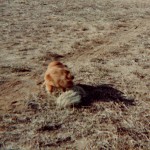 personal cost is. I can’t even begin to guess how many dogs have had encounters with porcupines, or skunks…much to their dismay later. Animals just don’t think about the consequences, unlike humans, who will quickly run the other direction when they see a skunk. And. dogs seem to be the world class leader when it comes to sticking their nose someplace where it is bound to get them in trouble.
personal cost is. I can’t even begin to guess how many dogs have had encounters with porcupines, or skunks…much to their dismay later. Animals just don’t think about the consequences, unlike humans, who will quickly run the other direction when they see a skunk. And. dogs seem to be the world class leader when it comes to sticking their nose someplace where it is bound to get them in trouble.
A dog meeting up with a skunk can be a really bad thing for his social life, but a dog meeting up with a porcupine can be extremely painful, so if it has to be one way or the other, I guess I would prefer skunk, if it were my dog. But, since you can’t really control everything that goes on in the animal world, I’m sure there will be other encounters with both porcupines and skunks. I don’t think there are very many animals that win against a skunk or a porcupine. Unfortunately, they seem to be a fairly formidable opponent.
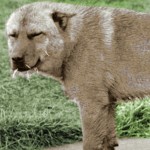 Needless to say, the family dog in this situation most likely ended up getting a smack on the nose with those razor sharp porcupine quills, and if he was smart, he probably learned a lesson that he didn’t quickly forget. Just because it looks smaller than you are, doesn’t mean that you can take it in a fight. It’s always best to know your opponent before you step into the ring. Porcupines don’t tend to just come up and attack you. They will wait until they feel that the threat is big enough that they have to fight for their survival before they take action. This particular porcupine appears to me to be trying to walk away, but the dog seems to have decided that he can take this opponent. My guess…It was a very bad day for that dog, because it’s never a good thing when dog meets porcupine.
Needless to say, the family dog in this situation most likely ended up getting a smack on the nose with those razor sharp porcupine quills, and if he was smart, he probably learned a lesson that he didn’t quickly forget. Just because it looks smaller than you are, doesn’t mean that you can take it in a fight. It’s always best to know your opponent before you step into the ring. Porcupines don’t tend to just come up and attack you. They will wait until they feel that the threat is big enough that they have to fight for their survival before they take action. This particular porcupine appears to me to be trying to walk away, but the dog seems to have decided that he can take this opponent. My guess…It was a very bad day for that dog, because it’s never a good thing when dog meets porcupine.
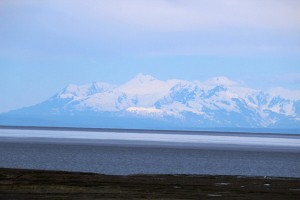 Our last day in Alaska, found Bob and me exploring the Anchorage area. None of our family had been there before, so this part was new territory. W had seen the pictures my parents took, but they didn’t get to go to Anchorage. I wanted to be able to give my mom and my sisters an idea of just how beautiful the Anchorage area is. We had planned to rent a car, but they are really expensive in Anchorage, and we love to walk, so we stored our luggage at the airport, and headed back to town. Once our shuttle got us to the downtown area, we started walking…without really knowing where we were going. It was almost like I knew where to go. I wanted to get down to the water, and the first thing we found was the Tony Knowles Coastal Trail. I felt like we had found our way. We started down the trail, and were pleased to see that the locals who used the trail were as friendly as the people we see on the trail near our house. We walked a ways, and were rewarded with beautiful views of the Knik Arm of the Cook Inlet.
Our last day in Alaska, found Bob and me exploring the Anchorage area. None of our family had been there before, so this part was new territory. W had seen the pictures my parents took, but they didn’t get to go to Anchorage. I wanted to be able to give my mom and my sisters an idea of just how beautiful the Anchorage area is. We had planned to rent a car, but they are really expensive in Anchorage, and we love to walk, so we stored our luggage at the airport, and headed back to town. Once our shuttle got us to the downtown area, we started walking…without really knowing where we were going. It was almost like I knew where to go. I wanted to get down to the water, and the first thing we found was the Tony Knowles Coastal Trail. I felt like we had found our way. We started down the trail, and were pleased to see that the locals who used the trail were as friendly as the people we see on the trail near our house. We walked a ways, and were rewarded with beautiful views of the Knik Arm of the Cook Inlet.
Off in the distance I captured a range of mountains, that I later realized contained a view of 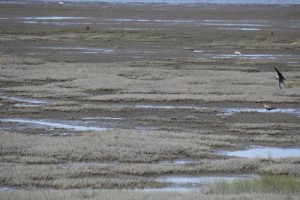 Mount McKinley. The native name for Mount McKinley is, of course, Denali, which means High One. I found the native words for things very interesting. For instance, the when we were in Juneau, I found out that auck means lake. That one was funny because of the English speaking people trying to help the natives name things. The natives had called it Auck, the English speakers liked it, so it became Auck Lake…or Lake Lake…which I found quite funny. Sometimes we just need to leave well enough alone.
Mount McKinley. The native name for Mount McKinley is, of course, Denali, which means High One. I found the native words for things very interesting. For instance, the when we were in Juneau, I found out that auck means lake. That one was funny because of the English speaking people trying to help the natives name things. The natives had called it Auck, the English speakers liked it, so it became Auck Lake…or Lake Lake…which I found quite funny. Sometimes we just need to leave well enough alone.
I was very excited about getting the picture of Denali, because it is so often shrouded in clouds, and is hard to capture without it being too covered. The mud flats on the Knik Arm were very strange. They looked like normal ground with grass, but in reality they were moss covered mud, and quite dangerous. People are warned to stay off of them. They tend to suck things in and refuse to let go…causing the death of humans or animals over the size of a bird.
As we walked along, the views continued to be breath taking. Bob was in hope that we would  be able to see the mud flats after the tide came in. We did not, but we could tell that the tide was starting to come in toward the end of our journey. I found myself quite amazed that we walked for about five hours, and the only issue I had, that day or the next was sore feet. I don’t know if we were just enjoying ourselves and not thinking about the time or distance that we had traveled or what made the difference, but I was happy, because I very much enjoyed that walk along the Tony Knowles Coastal Trail. I will never forget the amazing views we had in front of us. It was absolutely beautiful.
be able to see the mud flats after the tide came in. We did not, but we could tell that the tide was starting to come in toward the end of our journey. I found myself quite amazed that we walked for about five hours, and the only issue I had, that day or the next was sore feet. I don’t know if we were just enjoying ourselves and not thinking about the time or distance that we had traveled or what made the difference, but I was happy, because I very much enjoyed that walk along the Tony Knowles Coastal Trail. I will never forget the amazing views we had in front of us. It was absolutely beautiful.
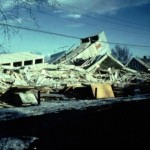
 While my husband, Bob and I were in Anchorage, Alaska recently, we went to the area visitor’s center, where we watched a movie about the 1964 Great Alaska Earthquake that occurred there. It was the largest earthquake in the history of the United States, registering 9.2 on the Richter Scale. The earthquake occurred on March 27, 1964 at 5:36pm, just 5 years after Alaska became the 49th state. It was Good Friday, and a lot of places had closed early for the holiday…a fact credited for savings lives. The death toll was relatively low, at 131…most of whom were killed by the tsunami that followed the quake. That number is amazing when you consider the magnitude of the quake. The property damage, was a very different thing. The main street became two levels. The school split into two sections, homes were leveled, and streets were split down the middle. All that is common in earthquakes…especially of that magnitude, but there were some things that were less common.
While my husband, Bob and I were in Anchorage, Alaska recently, we went to the area visitor’s center, where we watched a movie about the 1964 Great Alaska Earthquake that occurred there. It was the largest earthquake in the history of the United States, registering 9.2 on the Richter Scale. The earthquake occurred on March 27, 1964 at 5:36pm, just 5 years after Alaska became the 49th state. It was Good Friday, and a lot of places had closed early for the holiday…a fact credited for savings lives. The death toll was relatively low, at 131…most of whom were killed by the tsunami that followed the quake. That number is amazing when you consider the magnitude of the quake. The property damage, was a very different thing. The main street became two levels. The school split into two sections, homes were leveled, and streets were split down the middle. All that is common in earthquakes…especially of that magnitude, but there were some things that were less common.
At the Alaska Wildlife Conservation Center, there exists a stand of dead trees. It might make sense to cut these trees down, but it would not be an easy thing to do. The ground dropped 10 feet in the 1964 earthquake, and the influx of salt water from 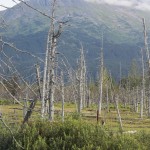
 the inlet killed the trees…petrifying them at the same time. To cut the trees down takes approximately 4 hours per tree, and seemed too impossible a job to tackle. The settlement of Portage, Alaska sank six feet, putting it below sea level. The town doesn’t really exist now, except as a ghost town. Everyone has had to relocate to nearby high ground.
the inlet killed the trees…petrifying them at the same time. To cut the trees down takes approximately 4 hours per tree, and seemed too impossible a job to tackle. The settlement of Portage, Alaska sank six feet, putting it below sea level. The town doesn’t really exist now, except as a ghost town. Everyone has had to relocate to nearby high ground.
But the area that hit me the most was an area called Earthquake Park. The four minutes that the earthquake rattled the area caused the Turnagain Heights neighborhood to virtually disappear. I guess the damage to that area is technically a landslide, but it was really more of a wave motion. During those four minutes, the land rolled up and down like a roller coaster. When the quake was over, many of the homes in that neighborhood had been literally swallowed up by the quake. As we looked at the area during our city tour and again as we walked the Tony Knowles Coastal Trail, it felt so strange to me. Our guide told us that if you walked through the land that went uphill and then down hill, just like a wave, you could still see chimneys sticking up out of the ground, where the home that was attached to them had literally disappeared beneath the earth. I simply couldn’t imagine what it must have been like to have the home you 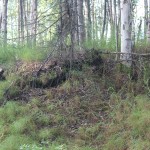
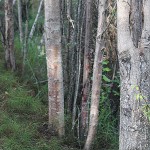 were in, be swallowed up by the earth. I was not able to get any death toll that was specific to the Turnagain Heights area, but with so many people home for the coming holiday, I think there must have been several or even more. It’s hard to describe what I felt in the Earthquake Park area, but I guess it was a mixture of awe and loss. I don’t know how that much devastation could occur on a holiday weekend, with no loss of life. The area felt like you needed to be quiet…as a show of respect maybe. I can’t really say exactly, I just know that it is a place I will not soon forget.
were in, be swallowed up by the earth. I was not able to get any death toll that was specific to the Turnagain Heights area, but with so many people home for the coming holiday, I think there must have been several or even more. It’s hard to describe what I felt in the Earthquake Park area, but I guess it was a mixture of awe and loss. I don’t know how that much devastation could occur on a holiday weekend, with no loss of life. The area felt like you needed to be quiet…as a show of respect maybe. I can’t really say exactly, I just know that it is a place I will not soon forget.
 As a kid, I heard the song, North to Alaska often. My parents were fascinated with the idea of going to visit there. Dad talked about it so much, that when it came time for their 50th Wedding Anniversary, our gift to them was a simple choice…a cruise to Alaska. They had such a wonderful time, and it was a memory that has lived on. Then a couple of years ago, I started thinking about how great it would be to see Alaska for myself. Everyone talked about how big Alaska was, and as a state, it is…very big, but that is not really what makes Alaska big…as I found out.
As a kid, I heard the song, North to Alaska often. My parents were fascinated with the idea of going to visit there. Dad talked about it so much, that when it came time for their 50th Wedding Anniversary, our gift to them was a simple choice…a cruise to Alaska. They had such a wonderful time, and it was a memory that has lived on. Then a couple of years ago, I started thinking about how great it would be to see Alaska for myself. Everyone talked about how big Alaska was, and as a state, it is…very big, but that is not really what makes Alaska big…as I found out.
There is a quality about Alaska that can’t be described any other way, but big…a vastness that you can actually feel. That was part of the draw for my parents, and then for me. I felt like the pioneers or gold rushers, setting out into the unknown. Yes, it was quite different for me than it was for them, because so many had traveled before me, and the route is known. There are guides all the way. Still, you get a feeling of being in the wilderness, in the last frontier. Alaska truly is just that, the last 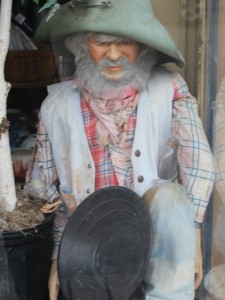 frontier, and yet, how could that still be when it has been a state for 55 years? I suppose that it is because much of Alaska hasn’t changed in all those years. About 94% of the state is still uninhabited…at least by permanent residents. Just knowing that makes Alaska have an air of mystery…of wildness.
frontier, and yet, how could that still be when it has been a state for 55 years? I suppose that it is because much of Alaska hasn’t changed in all those years. About 94% of the state is still uninhabited…at least by permanent residents. Just knowing that makes Alaska have an air of mystery…of wildness.
While in Alaska, I found myself wondering what the gold rush was like. We watched a movie at the visitors center in Anchorage, about the Klondike Gold Rush, and I realized that not only were lives lost in the search for wealth, but lives were destroyed. People lost everything they had…betting on the possibility of striking it rich. Around 100,000 men set out on the journey to the Klondike region in northwestern Canada, most of them by way of Skagway, White Pass, and the Yukon River, where they sailed to the Klondike, but only about 30,000 to 40,000 made it. The rest gave up, or died. Alaska is a place that is very unforgiving. The mountains are very high and topped with glaciers. It was cold and filled with steep climbs. Citrus fruit was scarce, so Scurvy was common. It was a really miserable place to be in winter, and yet they came.
There is still something about Alaska that draws people to it. Yes, there is still gold in Alaska,  but there is much more to it than that. There is something about its vast wilderness that challenges them…keeps them there or keeps them coming back. Maybe it’s the beauty of the whole place, or the mountains rising sharply right out of the water,…that are able to dwarf a cruise ship, or any other vessel. It could be the hunting and fishing, or maybe the whale watching. It could be any or all of those things, but for me it was a combination of several of these, coupled with a desire to see the things my parents had seen on their trip. So far, Bob and I are the only ones in the family to go to Alaska, besides Mom and Dad, but if I’m not mistaken, more will follow. Alaska has a way of calling your name…drawing you north.
but there is much more to it than that. There is something about its vast wilderness that challenges them…keeps them there or keeps them coming back. Maybe it’s the beauty of the whole place, or the mountains rising sharply right out of the water,…that are able to dwarf a cruise ship, or any other vessel. It could be the hunting and fishing, or maybe the whale watching. It could be any or all of those things, but for me it was a combination of several of these, coupled with a desire to see the things my parents had seen on their trip. So far, Bob and I are the only ones in the family to go to Alaska, besides Mom and Dad, but if I’m not mistaken, more will follow. Alaska has a way of calling your name…drawing you north.

